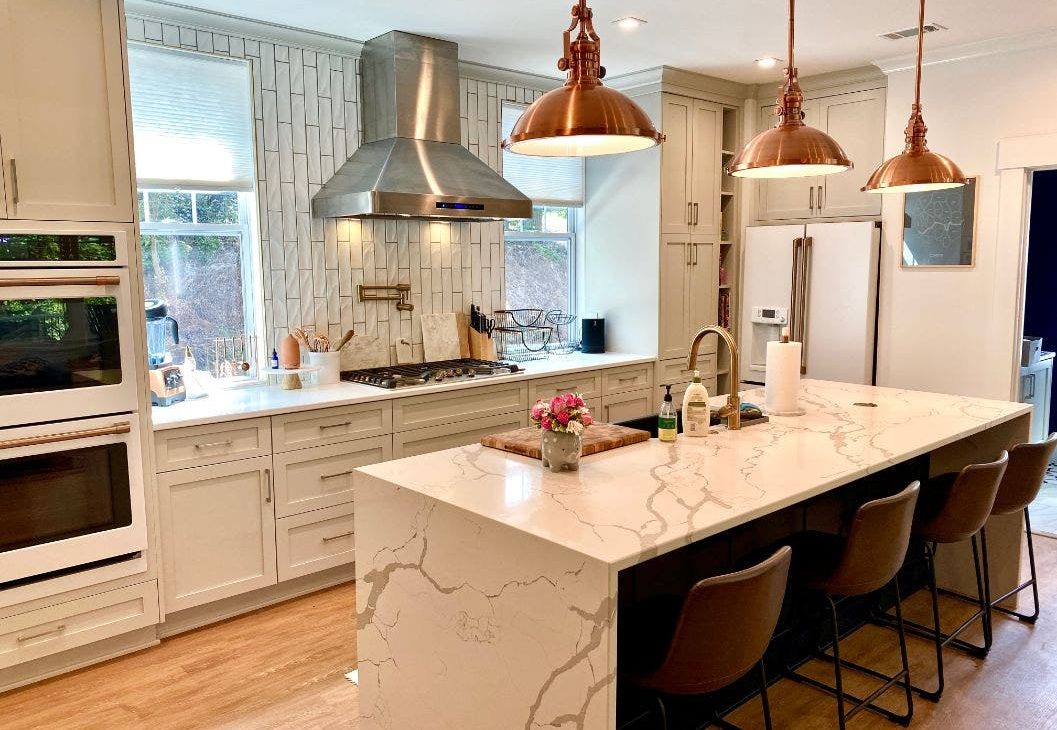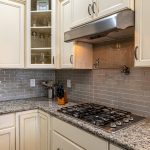For residential kitchens, a range hood should provide 100 cfm per linear foot of the range. However, for commercial kitchens, the recommended rate is 200 cfm per linear foot of the range.
Choosing the right cfm value for your kitchen is important for proper ventilation and air quality. Neglecting this requirement can lead to poor performance and unsafe conditions. A range hood is a vital element in any kitchen as it helps to eliminate smoke, cooking fumes, and other unwanted air impurities.
Range hood cfm (cubic feet per minute) is a rating that helps you to decide how powerful a range hood you need. It refers to the amount of air that the exhaust system can move per minute. Determining the correct cfm value is an important yet confusing task. Many factors such as the size of your kitchen, cooking habits, and gas burners dictate the required cfm. Understanding these factors can help you choose the right range hood that fits your lifestyle and cooking needs.

Credit: robamliving.com
Understanding What Cfm Means For Your Range Hood
If you’re considering purchasing a new range hood, it’s essential to understand cfm and how it affects your kitchen air quality. Here, we’ll take a closer look at what cfm is, why it’s important, and how to determine the right cfm for your particular kitchen size and cooking habits.
We’ll also dispel some of the common myths surrounding cfm.
What Is Cfm And Why Is It Important?
Cfm stands for cubic feet per minute, a measure of the amount of air a range hood can move in one minute. It’s an essential factor to consider when purchasing a range hood as it impacts its effectiveness in removing smoke, odor, and other airborne particles from your kitchen.
A range hood with a higher cfm can move more air, while a range hood with a lower cfm may not be effective at removing all the airborne pollutants from your kitchen.
How Does Cfm Affect Your Kitchen Air Quality?
The right cfm for your kitchen is crucial to maintain fresh and breathable air, and it largely depends on your kitchen’s size and your cooking habits. Cooking generates smoke, grease, and other small airborne particles that need to be removed from your kitchen.
A range hood with a lower cfm may not be up to the task and may leave smoke, grease, and other pollutants lingering in the air. This can affect the quality of the air you breathe in your home and can cause respiratory problems over time.
Determining The Right Cfm For Your Kitchen Size And Cooking Habits
Determining the right cfm for your range hood depends on your kitchen size and cooking habits. To determine the right cfm, you can follow these steps:
- Calculate your kitchen’s square footage by multiplying the length by the width to obtain the total area.
- Determine your cooktop’s btu (british thermal unit) rating. You’ll need to know how many btus your stove or cooktop can produce to determine the right cfm for your range hood.
- Once you’ve calculated your kitchen size and btu rating, use the industry-standard formula: Cfm = (kitchen square footage x ceiling height x cooktop btu)/4. This will give you the minimum cfm required for your range hood.
Common Myths About Cfm
There are various myths about cfm, including:
- The higher the cfm, the better the range hood: While cfm is a crucial factor to consider when buying a range hood, it’s not the only one. A range hood with the highest cfm may be too loud or too big for your kitchen.
- Bigger is always better: Choosing a range hood that’s too big for your kitchen may not always be the best option. If your range hood is too big, it may reduce the airflow, making it less efficient.
- Cfm is only important for gas stoves: This is not true as both gas and electric stoves produce smoke, odor, and other airborne pollutants that need to be removed from your kitchen.
Understanding cfm and its importance is crucial when selecting a range hood that meets your kitchen’s needs. Consider the size of your kitchen, your cooktop’s btu rating, and your cooking habits when determining the right cfm for your range hood.
Factors To Consider When Choosing The Right Cfm
A range hood is an essential kitchen appliance that promotes good hygiene and gets rid of unwanted odors while cooking. However, choosing the right cfm can be challenging, especially if you’re not familiar with its related factors. Here are the crucial factors to consider when choosing the right cfm for your range hood:
Your Kitchen Size And Layout
The size and layout of your kitchen play a significant role in determining the appropriate cfm rating for your range hood. Here’s what you need to know:
- For smaller kitchens, with a size of fewer than 75 square feet, a range hood with a cfm rating of 150 to 300 is sufficient.
- For medium-sized kitchens, which have an area of 76 to 100 square feet, consider getting a range hood with a cfm rating of 300 to 400.
- Larger kitchens, which are more than 100 square feet, require a range hood with more powerful suction- about 400 cfm or above. Additionally, consider getting multiple ventilation systems or a range hood with an extractor fan to meet your ventilation needs.
Your Stove’S Heat Output
The stove’s heat output is another crucial factor to consider when choosing the right cfm rating for your range hood. Here’s what you need to know:
- Electric stovetops emit less heat than gas stovetops, which means a range hood with a cfm rating of 100 to 300 is sufficient.
- Gas stovetops, which emit more heat, require a range hood with a higher cfm rating of 300 or more. It’s essential to choose a range hood that can handle the maximum heat output to avoid smoke and odor build-up in your kitchen.
The Type Of Cooking You Do Most Often
The type of cooking you do most often determines the appropriate cfm rating for your range hood. Here’s what you need to know:
- If you do light cooking, like steaming or boiling, consider getting a range hood with a low cfm rating of about 150 to 300.
- If you do moderate cooking, like stir-frying or sautéing, a range hood with a cfm rating of 300 to 400 is ideal.
- If you do heavy-duty cooking, like frying or grilling, consider getting a range hood with a cfm rating of about 400 cfm or more to handle the increased smoke and odor production.
The Ductwork And Ventilation System In Your Home
The ductwork and ventilation system in your home also play a vital role in determining the appropriate cfm rating for your range hood. Here’s what you need to know:
- If your home has a short and straight ducting system, consider getting a range hood with a lower cfm rating of about 150 to 300.
- If your ducting system is long or has multiple angles, which may reduce airflow, choose a range hood with a higher cfm rating of 300 or more.
- Ensure your range hood is well-matched with your home’s ventilation system to maximize efficiency and maintain a healthy indoor air quality.
Noise Level Considerations
Noise level is another critical factor to consider when choosing the right cfm rating for your range hood. To minimize noise pollution in your kitchen, consider these points:
- If you prefer a quieter kitchen, choose a range hood with a lower cfm rating since they tend to be quieter.
- However, keep in mind that higher cfm ratings mean more powerful exhaust fans, which results in louder noise production.
- Look for range hoods with noise level ratings of fewer than 7.0 sones or with sound reduction features to minimize noise pollution in your kitchen.
Types Of Range Hoods And Their Suitable Cfm
Wall-Mounted Range Hoods
Wall-mounted range hoods are popular types of range hoods as they are easy to install and maintain. Here are the suitable cfm and key features of wall-mounted range hoods:
- Recommended cfm: 200-900
- Key features:
- These range hoods are mounted on the wall above the cooking area.
- Suitable for kitchens where the stove is against a wall.
- Can be vented outside or recirculating.
Island Range Hoods
Island range hoods are specifically designed for kitchens with stovetops located on an island. Here are the suitable cfm and key features of island range hoods:
- Recommended cfm: 600-900
- Key features:
- These range hoods are mounted on the ceiling above the cooking area.
- Suitable for kitchens with stovetops located on an island.
- Can be vented outside or recirculating.
Undercabinet Range Hoods
Undercabinet range hoods are installed under the cabinet above the stove and require very little space to install. Here are the suitable cfm and key features of undercabinet range hoods:
- Recommended cfm: 200-600
- Key features:
- These range hoods are mounted under the cabinets above the cooking area.
- Suitable for kitchens where space is limited.
- Can be vented outside or recirculating.
Downdraft Range Hoods
Downdraft range hoods are the perfect option when it comes to keeping the kitchen free of any unwanted smoke or food odors. Here are the suitable cfm and key features of downdraft range hoods:
- Recommended cfm: 300-900
- Key features:
- These range hoods are installed behind the cooktop and rise upwards when in use.
- Suitable for kitchens where overhead ventilation is not possible.
- Best for use with electric cooktops.
Recirculating Range Hoods
Recirculating range hoods are designed to clean the air through a filter and recirculate it back into the kitchen. Here are the suitable cfm and key features of recirculating range hoods:
- Recommended cfm: 200-400
- Key features:
- These range hoods are suitable for spaces where venting outside is not possible.
- Recirculating range hoods clean the air through a filter and recirculate it back into the kitchen
- Met standard for air recirculation.
Remember, when selecting a range hood, it’s crucial to choose one that is suitable for your kitchen’s size and cooking needs. With the information we’ve provided on suitable cfm for each type of range hood, it should be easier to make an informed decision.
How To Measure Cfm: Step By Step Guide
How To Measure Cfm: Step-By-Step Guide
After discovering the importance of cfm in range hoods, you might wonder how to measure it. Fortunately, it is a simple process, and you can do it yourself with the necessary tools. By measuring your kitchen area and stove’s heat output, you will be able to determine the required cfm for your range hood.
Let’s dive into it!
Basic Tools You Will Need
Before getting started, make sure you have the following tools on hand:
- Tape measure
- Calculator
- Pen and notebook
How To Measure The Kitchen Square Footage
The first step is to measure your kitchen’s square footage. To do so, simply measure the length and width of your kitchen, multiplying the two measurements together to obtain the total square footage. Here’s an example:
- Length of kitchen: 12 feet
- Width of kitchen: 10 feet
- Total square footage: 120 square feet
How To Measure The Stove’S Heat Output
Your stove’s heat output will also affect the required cfm for your range hood. To determine how much heat your stove produces, follow these steps:
- Turn on all burners to the highest setting.
- Boil a pot of water that is at least 6 quarts in size.
- Once the water starts boiling, use a thermometer to measure the temperature of the steam rising off the pot.
Once you have the temperature, use the following chart to determine your stove’s heat output in btus (british thermal units):
- Temperature of steam rising off the pot: 212°f
- Btus of the stove: 40,000 btus
Cfm Calculation Formula And Examples
The formula for calculating your required cfm is as follows:
Cfm = (kitchen square footage x ceiling height) / 4 + (stove btus / 100)
Using the example measurements we took earlier, here’s how we would apply the formula:
Cfm = (120 x 8) / 4 + (40,000 / 100)
= 960 / 4 + 400
= 640 + 400
= 1040 Cfm
That means a range hood with at least 1040 cfm is required for our example kitchen.
Industry-Standard Cfm Guidelines
Now that you’ve calculated your required cfm, it is essential to know the industry-standard guidelines for range hood cfm. Here are the recommendations:
- For gas stoves or cooktops, aim for 100 cfm per linear foot of the stove.
- For electric stoves or cooktops, aim for 50 cfm per linear foot of the stove.
- For larger kitchens with more than 600 square feet, add 50 cfm for every additional 100 square feet.
By following these guidelines, you can ensure your range hood is effectively removing smoke, grease, and unpleasant odors from your kitchen.
Measuring cfm for a range hood is a simple process that is essential to keep your kitchen safe and clean. By following the step-by-step guide and industry-standard guidelines, you’ll be able to find the perfect range hood for your kitchen.
Tips For Maintaining Your Range Hood Cfm Performance
How To Ensure Your Range Hood’S Cfm Performance Is Top-Notch
Regular Cleaning And Maintenance ()
- Wipe down the range hood’s exterior at least once a month with a damp cloth and mild detergent to remove any accumulated grease and dirt.
- Regularly clean the mesh filters, disposable filters, or baffle filters to prevent grease build-up. Clean or replace them once a month or more frequently if you cook frequently or cook with high grease.
- Use a natural degreaser to clean the filters or soak them in hot water and soap for best results.
- For ducted range hoods, remove and clean the grease filters once every four to six weeks. Clean the motor blower wheel and fan blades annually. And make sure the duct system has no blockages or obstructions.
Replacing Filters And Parts Regularly ()
- Replace or clean the mesh filters, disposable filters, or baffle filters once every three to six months, depending on how frequently you cook.
- Replace carbon filters once every six months or according to the manufacturer’s recommendations.
- If there are any signs of damage, replace the grease filter or charcoal filter immediately.
- Replace the motor and fan if they stop working or spin slowly.
Cleaning And Maintaining The Ventilation System And Ductwork ()
- Inspect the ductwork for any cracks, holes, or damage that could affect airflow. Repair any leaks or damage as soon as possible.
- Check the ductwork and ventilation system every six to twelve months to ensure optimal performance.
- Clean the ductwork from the range hood to the exterior vent cover to remove accumulated grease, dust, and debris.
- Hire a professional to inspect and clean the ducts for you if you are unsure about the process.
Common Mistakes To Avoid When Maintaining Your Range Hood ()
- Not cleaning the range hood regularly.
- Not cleaning or replacing the filters regularly.
- Neglecting to check the ductwork and ventilation system for damage or obstructions.
- Not hiring a professional to clean or inspect the ducts when unsure of what to do.
- Ignoring signs of motor or fan damage.
By taking these simple steps, you’ll be sure your range hood is operating at peak performance, providing your kitchen with optimal ventilation and air quality.
Frequently Asked Questions Of How Many Cfm Do I Need For My Range Hood?
What Is Cfm In Range Hoods?
Cfm stands for cubic feet per minute, which measures the amount of air that the range hood can pull from the kitchen and remove outside.
How Much Cfm Do I Need For A Range Hood?
The rule of thumb for cfm is to have 1 cfm for every 100 btus your stove outputs, or at least 100 cfm for every linear foot of your cooktop.
What Happens If My Range Hood Has Low Cfm?
If your range hood has a low cfm, it may not be able to effectively remove smoke, steam, and odor from your kitchen, leading to poor indoor air quality.
How Much Noise Does A Range Hood With High Cfm Produce?
Range hoods with high cfm can produce between 7-9 sones of noise, which is equivalent to the noise level of a very loud conversation.
Can I Install A High Cfm Range Hood In A Small Kitchen?
Yes, you can install a high cfm range hood in a small kitchen, but ensure to choose a quieter range hood model with the required duct size for proper ventilation.
Are Ducted Range Hoods Better Than Non-Ducted?
Ducted range hoods are better than non-ducted, as ducted range hoods remove pollutants and moisture from your kitchen, unlike non-ducted range hoods that only filter air and recirculate polluted air back into the kitchen.
Conclusion
After all the research and learning about cfm, it’s clear that it’s an incredibly important factor when it comes to choosing a range hood. The size of your kitchen, your cooking habits, and the type of stove you have are all essential considerations when deciding on the right cfm rating for your range hood.
And with so many range hood options available, it can be challenging to find the right one that meets all your needs. However, having the right cfm flow rate for your kitchen size is a crucial first step. A range hood with too little cfm won’t do its job and a range hood with too much cfm will result in inefficiencies and noise pollution.
So, take the time to assess your needs and know what to look for when purchasing a range hood. By doing so, you will enhance your cooking experience, improve air quality, and create a safer and more comfortable space in your kitchen.

Freda is a passionate foodie and kitchen gadget enthusiast. With over 10 years of experience in the culinary industry, Freda brings her expertise in testing and reviewing kitchen gadgets.





